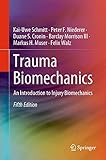Trauma Biomechanics [electronic resource] : An Introduction to Injury Biomechanics / by Kai-Uwe Schmitt, Peter F. Niederer, Duane S. Cronin, Barclay Morrison III, Markus H. Muser, Felix Walz.
By: Schmitt, Kai-Uwe [author.] .
.
Contributor(s): Niederer, Peter F [author.] | Cronin, Duane S [author.]
| Cronin, Duane S [author.] | Morrison III, Barclay [author.]
| Morrison III, Barclay [author.] | Muser, Markus H [author.]
| Muser, Markus H [author.] | Walz, Felix [author.]
| Walz, Felix [author.] | SpringerLink (Online service)
| SpringerLink (Online service) .
.
Material type:  BookPublisher: Cham : Springer International Publishing : Imprint: Springer, 2019Edition: 5th ed. 2019.Description: XVIII, 287 p. 128 illus. online resource.Content type: text Media type: computer Carrier type: online resourceISBN: 9783030116590.Subject(s): Biomedical engineering
BookPublisher: Cham : Springer International Publishing : Imprint: Springer, 2019Edition: 5th ed. 2019.Description: XVIII, 287 p. 128 illus. online resource.Content type: text Media type: computer Carrier type: online resourceISBN: 9783030116590.Subject(s): Biomedical engineeringIntroduction -- Methods in Trauma Biomechanics -- Head Injuries -- Spinal Injuries -- Thoracic Injuries -- Abdominal Injuries -- Injuries of the Pelvis and the Lower Extremities -- Injuries of the Upper Extremities -- Impairment and injuries resulting from chronic mechanical exposure -- Ballistic and Blast Trauma -- Solutions to exercises.
This well-established book on injury biomechanics has been extensively revised and expanded for this new edition. It now includes a fundamental treatment of the mechanics at a cellular level, written by the new coauthor Prof. Barclay Morrison III from Columbia University. Furthermore, considerably more attention is paid to computer modeling, and in particular modeling the human body. The book addresses a wide range of topics in injury biomechanics, including anatomy, injury classification, injury mechanisms, and injury criteria. Further, it provides essential information on regional injury reference values, or injury criteria, that are either currently in use or proposed by both US and European communities. Although the book is intended as an introduction for doctors and engineers who are newcomers to the field of injury biomechanics, sufficient references are provided for those who wish to conduct further research, and even established researchers will find it useful as a reference guide to the biomechanical background of each proposed injury mechanism and injury criterion.


There are no comments for this item.